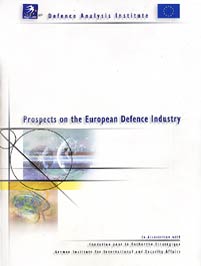Preface
Introduction
The European Defence Industrial Base and ESDP
RESTRUCTURING OF THE EUROPEAN DEFENCE INDUSTRY
THE INDUSTRY-LED RESTRUCTURING PROCESS1997-1999 : the European defence industry under pressure- Firms seek economies of scale and enlargement of the market
- State/industry consensus on the need for industrial consolidation
From international cooperation to transnational integration- The first cooperative programmes, common subsidiaries and joint ventures
- Privatisation
- Concentration
- Groups with diversified activities
Appraisal by sector of activities- Defence aerospace and electronics : a strategy of segment consolidation
- The land and naval armaments sectors : an industrial scene divided along national lines
Trends in European defence industrial direct employement- Overview
- Situation by country
THE OPERATING ENVIRONMENTThe permanence of the Europe/United States imbalance- Unfavourable conditions...
- ...the US strategy of expansion in Europe
First initiatives aimed at creating a favourable environment for European defence industries- Creation of ad hoc structures by the principal armaments producing countries (Germany, United Kingdoms, France, Italy, Spain and Sweden)
- First steps towards an institutional strategy for the EU in the field of armaments
ALL-UNION INITIATIVES, ENHANCED COOPERATION AND CONVERGENCE OBJECTIVES
ALL-UNIONS INITIATIVESThe establishement of a European Armaments Agency (EAA) Prospects for all-Union initiatives short of fully-fledged procurement functions- Research and development
- Improving the industry-government interface
- Programme management
ENHANCED COOPERATIONEDIB-related enhanced cooperation- Programme management
- The creation of NATO-style defence infrastructure programmes
ESDP-related cooperation with EDIB consequences- Strategic lift
- Homeland Defence
CONVERGENCE OBJECTIVESConvergence objectives monitoring implementation Input objectives- Equipment expenditure as a share of defence spending
- Defence equipment expenditure as a percentage of GDP
- Defence equipment expenditure per capita
- Defence equipment expenditure per military person
Transatlantic Gaps and European Armaments Co-operation
The spending capability and technology gap and the European defence technological and industrial base- Are different spending levels across the Atlantic creating a 'gap'?
- Capability shortfalls of European armed forces
- Co-operability and interoperability but not gap-closing as the central transatlantic challenge
- The political relevance of a European defence technological and industrial base (DTIB)
- Interdependence between governments and industry
Spending scarce defence budgets more efficiently by deepening European armaments co-operation- Characteristics of the "European armament system" undermining competitiveness
- Trends
- European procurement reform : issues to be considered
European armament / defence industrial future- Scenario I : Fragmented Europe
- Scenario II : Core Europe
- Scenario III : A Vision - Integrated Europe
Concluding remarks : the specificity of the defence sector and European comptitiveness
|



